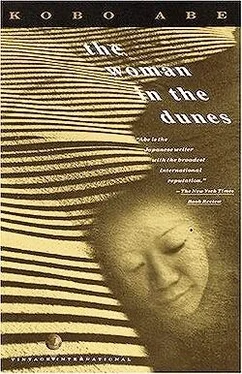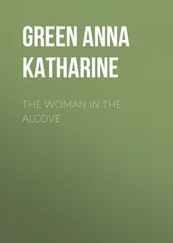In some way, winter passed and spring came. At the beginning of March they got the radio. On the roof they erected a high antenna. The woman joyfully and repeatedly voiced her wonder, turning the dial left and right for half a day. At the end of that month, she found herself pregnant. Two more months went by. Large white birds kept flying over from east to west for three days in succession, and on the following day the lower part of her body was covered with blood and she complained of violent pain. One of the villagers, who was said to have a veterinarian among her relatives, diagnosed it as an extra-uterine pregnancy, and it was decided to take her to the hospital in the city in the three-wheeled truck. The man sat with her as they waited for the truck to come, letting her hold one of his hands, while with the other he kept rubbing her belly.
Finally the three-wheeler stopped at the top of the cliff. A rope ladder was let down for the first time in a half year, and the woman, wrapped in her blankets as in a cocoon, was hauled up by rope. She looked at him beseechingly with eyes almost blinded by tears and mucus, until she could see him no longer. The man looked away as if he did not see her.
Even though she had been taken away, the rope ladder remained as it was. He hesitantly reached out and touched it with his fingertips. After making sure it would not vanish, he slowly began to climb up. The sky was a dirty yellow. His arms and legs felt heavy, as if he had just come out of water. This was the long-awaited rope ladder.
The wind seemed to snatch the breath from his mouth. Circling around the edge of the hole, he climbed to a spot where he could view the sea. The sea too was a dirty yellow. He breathed deeply, but the air only irritated his throat, and it did not taste as he had expected. He turned around. A cloud of sand rose on the outskirts of the village. It was probably the three-wheeler with the woman, he thought. Oh, yes… maybe he should have told her the real significance of the trap.
Something moved at the bottom of the hole. It was his own shadow. Just near it stood the water trap. One part of the framework had come loose. Perhaps someone had accidentally stepped on it when they had come to take the woman out. He hastened back down the ladder to repair it The water, as his calculations had led him to expect, had risen to the fourth mark. The damage did not appear to be too great. In the house, someone was singing in a rasping voice on the radio. He tried to stifle the sobbing that seemed about to burst from him; he plunged his hands into the bucket. The water was piercingly cold. He sank down on his knees and remained inert, his hands still in the water.
There was no particular need to hurry about escaping. On the two-way ticket he held in his hand now, the destination and time of departure were blanks for him to fill in as he wished. In addition, he realized that he was bursting with a desire to talk to someone about the water trap. And if he wanted to talk about it, there wouldn't be better listeners than the villagers. He would end by telling someone — if not today, then tomorrow.
He might as well put off his escape until sometime after that.
NOTIFICATION OF MISSING PERSONS
NAME OF PERSON: Niki Jumpei
DATE OF BIRTH: March 7
In view of the fact that a notice of missing person (s) has been filed by Niki Shino (mother), notification of the existence of the missing party should be made to this court by September 21, 1962. In the event of no further report, the said person will be pronounced missing. Anyone knowing anything about the person in question is requested to report to this court by the above date.
February 18,1962
COURT OF DOMESTIC RELATIONS JUDGMENT
CLAIMANT: Niki Shino
MISSING PERSON: Niki Jumpei
DATE OF BIRTH: March 7
A declaration of disappearance concerning the abovementioned party having been filed, the procedure of public notice having been fulfilled, and the unascertainability of either the existence or the death of the person in question from August 18, 1955, for seven years hence, having been recognized, the following decision has been handed down.
DECISION
Niki Jumpei is hereby declared missing.
October 5,1962 COURT OF DOMESTIC RELATIONS
SIGNATURE OF JUDGE.
The End
A Note About the Author

Kobo Abe was born in Tokyo in 1924 but grew up in Mukden, Manchuria, where his father, a doctor, was on the staff of the medical school. As a young man Mr. Abe was interested in mathematics and insect collecting as well as the works of Poe, Dostoevski, Nietzsche, Heidegger, Jaspers, and Kafka. He received a medical degree from Tokyo University in 1948, but he has never practiced medicine. In that same year he published his first book, The Road Sign at the End of the Street. In 1951 he was awarded the most important Japanese literary prize, the Akutagawa, for his novel.
The Crime of Mr. S. Karuma. _In 1960 his novel The Woman in the Dunes_ won the Yomiuri Prize for Literature. It was made into a film by Hiroshi Teshigahara in 1963 and won the jury prize at the Cannes Film Festival. It was the first of Mr. Abe's novels to be published in translation in the United States, in 1964. The Face of Another (1966)_ was also made into a film by Mr. Teshigahara. Other novels in translation include The Ruined Map (1969), Friends (1969), The Box Man (1974), and The Man Who Turned Into a Stick (1976).
A Note About the Translator
E. Dale Saunders, translator of Kobo Abe's The Woman in the Dunes (1964), The Face of Another (1966), and The Ruined Map (1969), received his A.B. from Western Reserve University (1941), his M.A. from Harvard (1948), and his Ph.D. from the University of Paris (1952). He is Professor of Japanese Studies at the University of Pennsylvania, having previously taught at International Christian University, Tokyo, and at Harvard University. Among his publications are Mudra: A Study of Symbolic Gestures in Japanese Buddhist Sculpture (1960) and Buddhism in Japan (1964).













